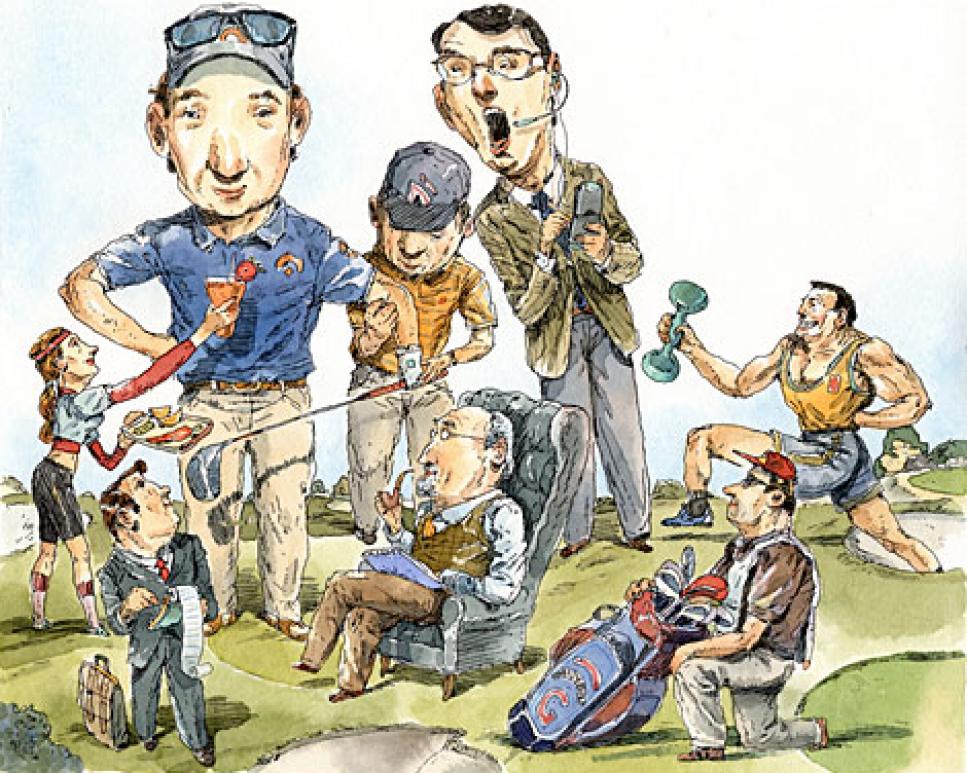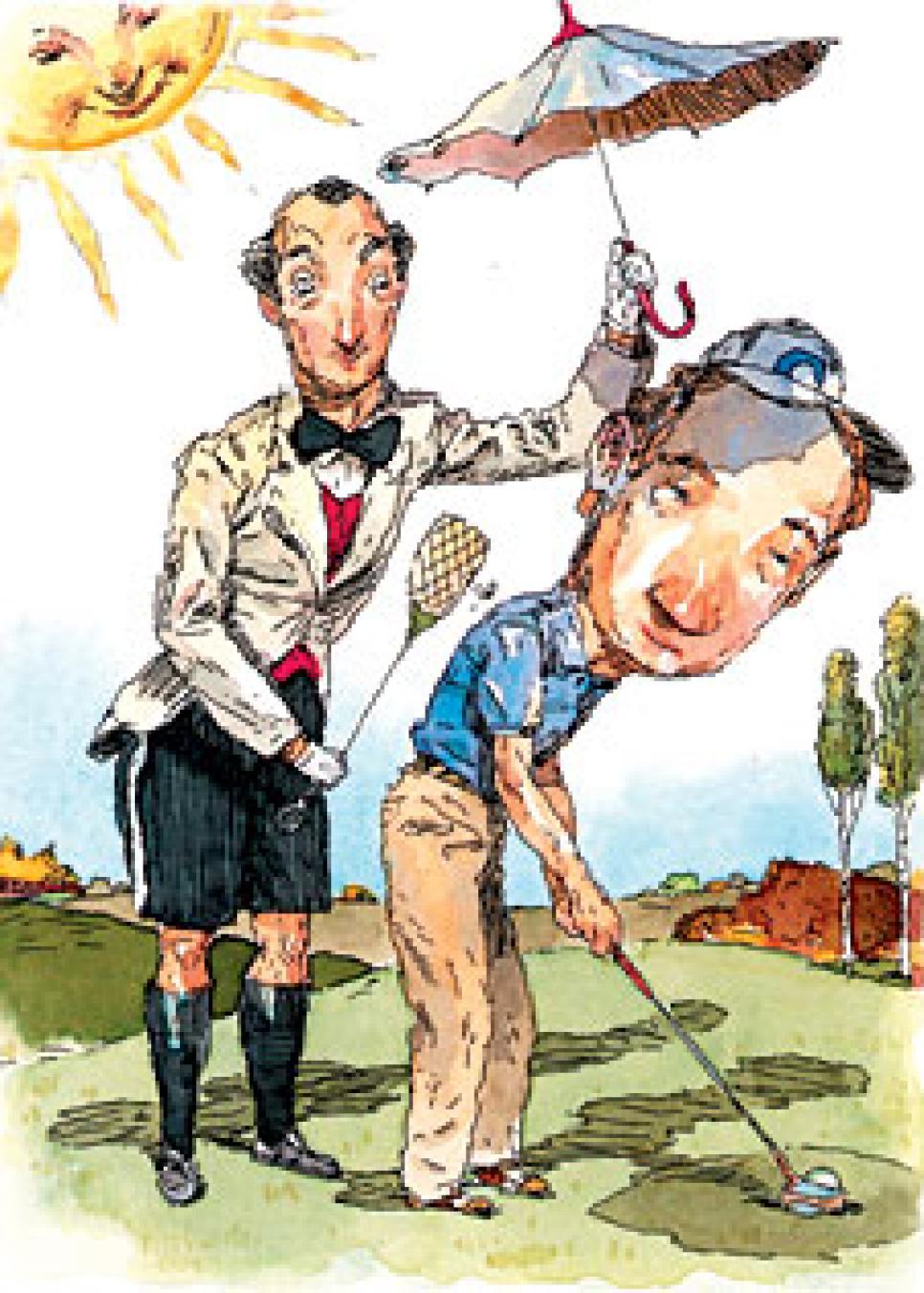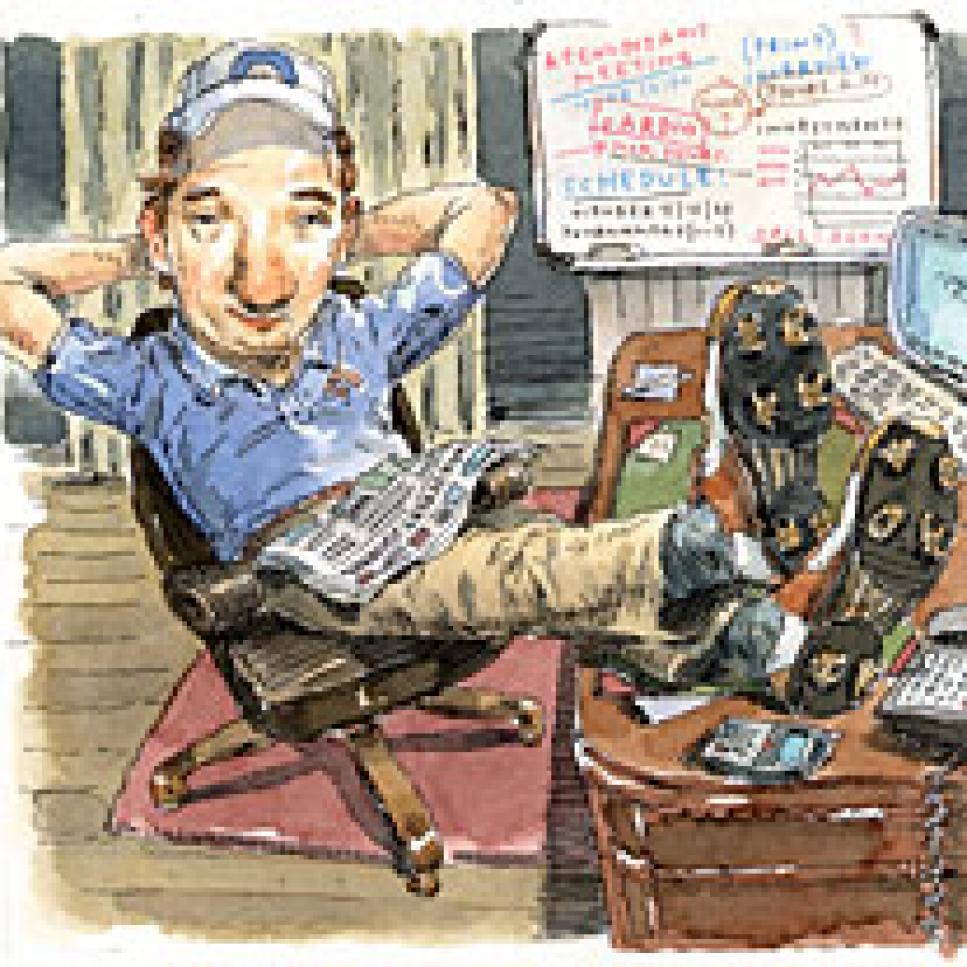News
It Takes A Village

"Globe-trotting golf is a solitary existence," Gary Player wrote in his 1991 autobiography To Be the Best. "I eat alone. I practice alone … It is just me against the rest." Well, not quite, Gary: Professional golf has become a team sport.
Like Academy Award-winning actors, today's tournament winners have a lot of people to thank, and we don't just mean Mom and Dad and the tournament sponsor. It takes a village. The modern player's payroll invariably includes an agent, a caddie, a financial adviser and a swing instructor (and maybe even a wife or significant other). Sport psychologists are almost de rigueur, and coaches for wedges, putting, and fitness are not at all unusual. Nutritionists tend to a few tummies on the PGA Tour, and spiritual advisers soothe a score of souls. Agent Dennis Harrington predicts that gentlemen's gentlemen—valets—will be the next big thing.
Cynics contend that the sport's pressures have created a generation of fragile athletes trying to diffuse responsibility with employees nodding their heads, and that the tour is an island of money surrounded by people who want some. "Maybe," says Pat O'Brien, putting mentor to 2007 Masters champion Zach Johnson, "having more people on your team is a way to deal with the loneliness of golf." The tripling of PGA Tour prize money in the last decade (to about $277 million) permits more employee overhead, of course, but the main point is this: Modern professionals think more help helps.
The culture has changed. Younger players do not see themselves as heroically alone, as Player does. Those who came up through the academy system are comfortable with a team of teachers and trainers because that's how they did it in high school. Although simplicity is the players' often-stated goal for their army outside the ropes, more employees inevitably means more complication. Who hires and who fires, and on what basis? Should your agent also be your business manager? Should your business manager also be your accountant? Do you want your wedge guy and your swing instructor talking? Should your caddie drive your nanny in your RV to the next tournament?
It all used to be so simple. "No one had his own caddie," recalls 86-year-old Jack Burke Jr., a star of the post-World War II tour. "Instructors? No. We were all instructors. If I was having trouble, I'd get whoever was on the practice tee to watch me. Johnny Revolta, Vic Ghezzi, Paul Runyan, George Fazio—they were great teachers. Today's players need so much help because they have never learned their trade. They've never taught. When they face a little adversity, they go looking. They'd take a lesson from a ball washer."
In Burke's era, when the annual purse was measured in the hundreds of thousands and not the hundreds of millions, there was really only one agent, a garrulous Bostonian named Fred Corcoran, who had basically one client: Sam Snead. If you wanted Ben Hogan to endorse your cigarettes or play an exhibition at your club, you asked Ben Hogan.
As in so many things in golf, things changed when Arnold Palmer burst on the scene. The year 1958 was key: Prize money eclipsed $1 million for the first time, and Palmer led the list with $42,607.50. That November, Palmer had a meeting at the Heart of Atlanta Motel with a bright young lawyer from Cleveland. Mark McCormack had a big idea—represent golf pros to the world of business. McCormack had already sold the concept to Billy Casper, Dow Finsterwald and Art Wall. Palmer came on board, the angels sang, and thus was born golf's ber-agency, IMG.

"Probably the top 80 guys [of the roughly 150 following the tour] had their own caddies when I played [1968 through 1975]" says Rick Rhoads, the longtime pro at San Francisco GC. "The rest of us hired local caddies, or high school or college kids. As for swing instructors, Palmer had his dad, Dave Stockton had his dad, Jack Nicklaus had Jack Grout—but teachers seldom went to tour events. The main thing we used was the Hogan book [Ben's immortal instructional Five Lessons].
"The tournament winners had agents, mostly for getting them exhibitions," Rhoads continues. "Trainers? I spoke with Jack LaLanne once. A few of us sought psychological training, but back then a lot of players intuitively understood the mental side … I think then, and now, you get the marginal player going for extra help because he thinks he has to."
Dean Wilson is more than a marginal player—he won the 2006 International and more than $2.6 million in the last two years—but he isn't Tiger Woods. He chuckles at the idea that he employs an entourage because he does his strength work on a pay-as-you-go basis at Tim Soder's gym back home in Las Vegas, he isn't married and, to get his head right, he only reads Bob Rotella. On the other hand, he's got two swing coaches, Mike Bennett and Andy Plummer; a financial adviser, Dino Macaluso in Albany, N.Y.; a short-game guru in James Sieckmann; a top caddie, Mike Bestor; and an agent. His staff size is more or less typical.
"Yes, I've noticed more players employing more and more people," Wilson says. "It's because the competition is getting better. You've got to get to your highest level in strength, swing and how you think."
Hollywood invented the entourage. For almost a century, narcissistic stars have traveled with their poodles and publicists, foisting the expense onto the studio or the production company. Newly rich basketball and football players take a similar tangent, giving make-believe jobs to a security blanket of old friends and family. These performers seem childish compared to athletes bearing the strain of a year-round road trip, but tour pros face the same temptation to hire familiar people. The question must eventually arise: What is more important in life, relationships or your position on the money list? What will Thanksgiving dinner be like if you've fired your dad?
Bringing family into the golf business happens all the time. Mark Immelman tunes the sweet swing of his brother Trevor, the 2008 Masters champion. Caddies with blood or marriage ties to their employers have been part of the tour for years, such as Padraig Harrington utilizing brother-in-law Ronan Flood. Agents, too: Jim Lehman has represented his brother Tom for a long time. Got a deal for Seve Ballesteros? Call his brother, Baldomero. After years with Rocky Hambric's company, Lorena Ochoa now uses her brother, Alejandro. But hiring family ended tragically for Davis Love III. Jeffrey Knight, Love's brother-in-law (married to his wife's sister), handled travel, bill-paying and day-to-day logistics for Davis. After the FBI questioned him in May 2003 about approximately $1 million missing from one of Love's accounts, Knight shot himself.
Family apart, sheer size can be a problem, "especially when everybody's not on the same page," says Dr. Morris (Mo) Pickens, a Sea Island, Ga.-based sport psychologist whose clients include Johnson and Vaughn Taylor. "I could be focusing on process, while the swing guy is telling our player to just go out and win—focusing on results, in other words. That's why we always have a two-or three-day meeting at the end of the year. … It doesn't matter how many people are on the team. What matters is that you have one message."
If handling an entourage seems daunting, agents such as Harrington are willing to step into the breach. "I tell my players, 'You're the CEO, I'm kind of the coach, the voice of reason,' " says Harrington, a former player who began his career as a pro golf agent with Links Sports in 1999. He's just hung out a shingle—Orasi Sports (orasi means "vision" in Greek). His clients include Chad Campbell, Ryan Palmer and Bubba Dickerson.

"How the team is compensated is very complicated," says Harrington. "It's across the board—expenses, a retainer, a certain dollar amount per tournament. Caddies make $1,000 or $2,000 a week plus 5 percent of winnings. Usually they get 7 percent for a top-10 and 10 percent for a win."
A $2- or $3-million dollar winner is obviously paying a caddie a couple of hundred thousand dollars annually. How much for the rest? "If you tried to put a number on it you'd look silly," says David Winkle of Hambric Sports Management. "The range is tremendously broad. Some instructors want nothing, or just expenses, while others get a bunch. The agent's income depends on the deals he can get based on the player's marketability. Sports psychologists usually charge a day rate." Three tour stars with reputations for generosity to their teams are Phil Mickelson, Adam Scott and Hambric client Justin Leonard. Whose support team is biggest? Some tour sages nominate Vijay Singh. ("I saw him arrive at Akron [in 2007], and [the entourage included] kids, and dogs, and trainers," a shaft company rep says); Phil Mickelson, probably more for instructor quality—Dave Pelz and Butch Harmon—than for quantity; and "anyone from Japan," given their need for interpreters and cadres of assistants. The smallest support staff belongs to Bubba Watson, the self-taught player who has no need of instructors (or fitness, nutrition or mental coaches) and whose wife, Angie, doubles as his agent.
Kristy McPherson is the Bubba Dub of the LPGA, with a bare-bones staff of caddie and agent. "I'm one of the very few without an instructor, but I've never taken lessons," says the Conway, S.C., native who finished T-2 at last month's Kraft Nabisco Championship. "Quite a few travel with five, six, seven, or eight. … I'm not opposed to people helping me, but I try to keep it simple. I'm plenty capable of doing things for myself."
For the large group of South Koreans on the women's tour, keeping it simple means more support staff, not less: mental and swing coaches, trainers, and one or both parents are common. Perhaps the growth of the entourages of the international players represents an understandable effort to create a comfortable, familiar society to travel with and socialize in. But Angela Stanford thinks youth has just as much to do with it.
"It's because the players have gotten younger," Stanford says. "That's why you see parents out [on the LPGA tour] and agents out. I'm about middle of the road. I've got an instructor, Mike Wright, and an agent, and I recently added a trainer. I also hired a company that does my website. What would I like next? In a perfect world, I'd have a personal assistant, someone to handle my travel stuff."
Even Gary Player, 73, the solitary warrior, has added staff. From an office in Palm Beach Gardens, Fla., Player now does business as Gary Player Group. Six agents.

